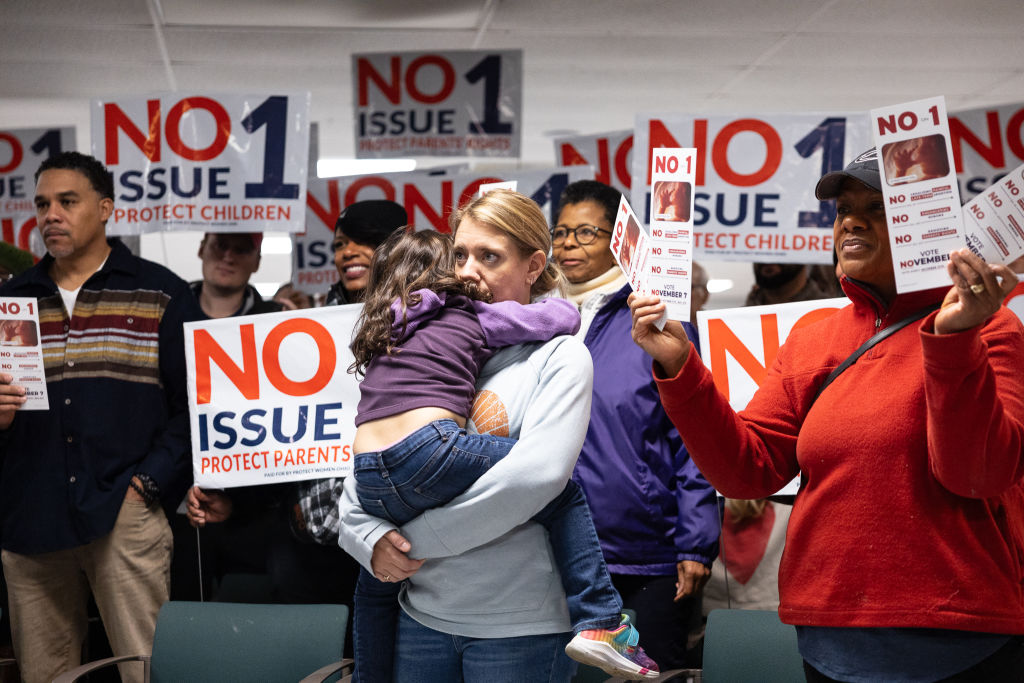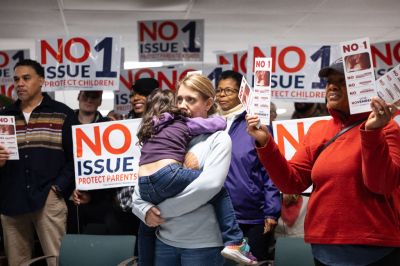Happy Monday! Andrew lost in all three of his fantasy football leagues this week. Please keep him in your thoughts during this trying time.
Up to Speed
- Voters head to the polls in several states this week for off-year elections, including gubernatorial contests in Kentucky and Mississippi and state legislative elections in Virginia. Kentucky’s Democratic Gov. Andy Beshear is being challenged by Republican state attorney general Daniel Cameron, while GOP Mississippi Gov. Tate Reeves takes on Democrat Brandon Presley.
- Iowa Gov. Kim Reynolds will endorse Florida Gov. Ron DeSantis for president at a Monday rally in Des Moines, the Des Moines Register first reported Sunday. The move isn’t unexpected: Reynolds and DeSantis have long shared a similar governing outlook, and Reynolds has frequently appeared at her Florida counterpart’s Iowa events. Her endorsement comes as DeSantis desperately needs a shot in the arm, failing to close former President Donald Trump’s huge polling lead in Iowa and slipping out of second place in several other key early states.
- Donald Trump lashed out at Reynolds after the news of her coming endorsement broke, calling her and DeSantis “two extremely disloyal people” and threatening that the endorsement would be “the end of her political career in that MAGA would never support her again.”
- The third Republican presidential debate of the year will take place this Wednesday evening in Miami. Ron DeSantis, Nikki Haley, Vivek Ramaswamy, Tim Scott, and Chris Christie have all qualified to participate; Donald Trump will once again skip the event and counterprogram it with a nearby rally.
- Trump is set to testify again under oath today in his ongoing New York civil fraud trial, where he is accused of inflating his net worth in documents to obtain better terms on loans from banks and insurers.
- Former Rep. Peter Meijer of Michigan announced Monday he is running for Senate, targeting the seat being vacated by outgoing Democratic Sen. Debbie Stabenow. The one-term lawmaker lost his House primary last year to a Trump-backed challenger, John Gibbs, over his vote to impeach the former president after January 6. Gibbs went on to lose to Hillary Scholten, a Democrat, in November. Meijer joins a Republican field that includes former Rep. Mike Rogers and former Detroit police chief James Craig.
Ohio to Decide on Abortion Rights Constitutional Amendment

Ohio voters will go to the polls tomorrow to decide a colossal question: whether to enshrine the right to an abortion in their state constitution.
It’s the latest test of how far abortion-access advocates can push their electoral advantage—and whether the pro-life side can stop the electoral bleeding—one year after the end of Roe v. Wade.
The measure, State Issue 1, would establish a “right to make and carry out one’s own reproductive decisions” while recreating Roe’s own restriction standard: permitting prohibitions on abortion after fetal viability except when “in the professional judgment of the pregnant patient’s treating physician it is necessary to protect the pregnant patient’s life or health.” Ohio currently bans abortion after 22 weeks. A six-week ban signed in 2019 by Republican Gov. Mike DeWine is currently stalled in state courts.
Long a coin-flip swing state, Ohio has trended redder and redder in recent years. Donald Trump beat Joe Biden by 8 points there in 2020, and Republican J.D. Vance beat Democrat Tim Ryan by 6 points in last year’s Senate contest.
But the furious backlash that followed the Supreme Court’s ending of nationwide legal abortion in Dobbs v. Jackson Women’s Health has recently been swamping anti-abortion ballot measures pretty much everywhere. Last year, voters in Montana, Kansas, and Kentucky—Trump +16, Trump +15, and Trump +26 states, respectively—all spiked ballot initiatives that would have permitted some form of new abortion restrictions in their states. Meanwhile, measures protecting abortion access sailed through by wide margins in Michigan, California, and Vermont.
Emboldened by these successes, legal-abortion supporters are swinging for the fences, making an aggressive direct-democracy push to hogtie GOP legislatures in any red states where state policy can be set by majority vote. Ballot operations for next year’s elections are well underway in Florida—where Gov. Ron DeSantis last year won a commanding reelection, then signed a six-week abortion ban—and South Dakota, the reddest state in the nation and one with a near-total ban on the practice.
But in the Buckeye State, advocates moved more quickly. A coalition of existing pro-choice groups amalgamated for the effort as Ohioans United for Reproductive Rights announced in mid-February they were targeting the November ballot. On July 5, they announced they had gathered nearly double the approximately 415,000 signatures they needed to qualify for the ballot.
Republicans in the legislature tried to head them off, holding a special election this summer to try to raise the amendment-approval threshold to 60 percent of the vote. But the strategy backfired. The ordinarily sleepy summer ballot saw huge turnout amid the widespread perception Republicans were trying to pull a fast one. The attempt to raise the threshold failed, 43 percent to 57 percent.
With all eyes on the state, tens of millions of outside dollars have poured into Ohio in recent weeks, with the pro-choice side heavily outraising and outspending pro-lifers on the issue. Since August 9, Ohioans United for Reproductive Rights has pulled in $28 million, while the leading group opposing the measure, Protect Women Ohio, has raised $9.9 million. According to spending tracker AdImpact, $33 million had been spent on ads as of late October, with the pro-choice side outspending the pro-life side by $6.5 million.
Youngkin Goes for GOP Control in Virginia
Local television in the Washington, D.C., area has been dominated by political ads in the final week before Tuesday’s legislative elections in Virginia. One commercial break during a recent evening news broadcast featured nothing but ads for candidates, with Democrats accusing Republicans of being extremists on abortion in one 30-second spot and Republicans casting Democrats as weak on crime and economic growth in the next. Lather, rinse, repeat.
Viewers in the National Capital Region are being subject to this barrage because the battle for control of Virginia’s state Senate and House of Delegates runs through several battleground districts in the greater Northern Virginia area. There are also competitive seats in both the Richmond suburbs and the Hampton Roads region up for grabs, almost all of them narrowly divided after having voted for President Joe Biden in 2020 and then for Virginia’s Republican governor, Glenn Youngkin, in 2021.
Just two years after Youngkin won his race for governor, the state’s leading Republican is trying to hold on to the GOP’s two-seat majority in the lower house while winning at least four seats to even up the partisan split in the senate, where Democrats are currently in power but the Republican lieutenant governor, Winsome Sears, would break a tie. Achieving all of that would not only give Youngkin unified control for his final two years in office—in Virginia, governors cannot serve consecutive four-year terms—but could further raise his profile as a successful Republican in an otherwise blue-trending state.
It’s why the governor’s political operation has raised more than $23 million in this cycle, spending most of it to boost Republican candidates, along with more than 100 personal stump appearances by Youngkin. And it’s not just candidates for the state legislature: Youngkin is urging support for Republican-aligned candidates in local offices like school board seats and county supervisors. That’s a big part of a plan to turn out as many Republican voters as possible with cultural issues like education and crime.
In an appearance on Fox News Friday morning, Youngkin urged people to vote in the school-board elections in Loudoun County—where it just so happens part of one crucial state Senate district is located.
“Elections are on Tuesday, and the entire Loudoun County school board is up for election on Tuesday,” Youngkin said. “And I encourage the Loudoun County voters, get out and make your voice heard, because it’s time to elect a new school board in Loudoun County.”
Youngkin will make his final campaign appearance for Republican candidates this cycle in Loudoun County on Monday evening after making stops during the day in Fredericksburg and Prince William County, all of which are in the populous, Democratic-heavy Northern Virginia region.
But Democrats are pushing back, chiefly by turning out their own base of voters over the issue of abortion. For the first legislative elections in Virginia since the Supreme Court overturned Roe v. Wade, Democratic candidates are charging their Republican opponents with holding unpopular views on the issue. Joel Griffin, a Democratic candidate for state senate in the Fredericksburg area in exurban Northern Virginia, said in one TV ad that his Republican rival Tara Durant “supports banning abortions, even allowing Virginia to ban it with no exceptions.”
Without their own charismatic in-state leader, Virginia Democrats have called in for support from Barack Obama. The former president won the Old Dominion twice, and he remains popular with the party’s base voters, particularly among African-American supporters in the Richmond and the Hampton Roads areas. As Politico reported last week, Obama has recorded generic robocalls to encourage Democrats to vote on Tuesday.
From Team Youngkin’s perspective, the governor has done everything, from burnishing his personal brand to deploying resources, to bolster the GOP in what is otherwise a difficult state. One area that will be ripe for analysis depending on the outcomes is the effectiveness of the Youngkin-led counter-message on abortion, which paints Democrats as the true extremists on the issue.
One TV ad on behalf of Republican house of delegate candidates features a female voiceover which says that “most people believe that abortion at the moment of birth is wrong. … Not Virginia Democrats.” The ad includes audio from Democratic state delegate Kathy Tran saying that a bill she sponsored would allow abortion at up to 40 weeks of gestation. “When Democrats say ‘no limits,’ they mean no limits,” the ad says.
And in a Sunday appearance on This Week on ABC News, Youngkin articulated the argument adopted by Republicans across the state, which proposes a “reasonable” limit on abortions after 15 weeks.
“It’s one of the most divisive topics across Virginia,” Youngkin conceded. “I think this is one where Virginians come together around reasonableness. And it then allows us to move onto really important topics.”
Brutal Biden Polling Sparks Four-Alarm Fire in Democratic Party
President Joe Biden was rocked Sunday by twin public opinion polls that exposed deep political vulnerabilities for the Democratic incumbent, casting doubt on his ability to win a rematch with Republican frontrunner Donald Trump that is now less than 12 months away.
The collection of half-dozen battleground surveys from Siena College and The New York Times is causing particular heartburn inside the Democratic Party. Only in Wisconsin was Biden beating Trump, 47 percent to 45 percent. The former president led everywhere else: 49 percent to 44 percent in Arizona, 49 percent to 43 percent in Georgia, 48 percent to 43 percent in Michigan, 52 percent to 41 percent in Nevada, and 48 percent to 44 percent in Pennsylvania. Not only did Biden capture all six states in 2020—it seems that the more diverse a state is, the worse his prospects.
In a YouGov poll for CBS News, Trump led Biden nationally 51 percent to 48 percent. But it was the response from likely 2024 voters under the hood of this survey that was most concerning to some Democratic insiders.
Forty-seven percent said “peace and stability would increase in the world” if Trump gets his old job back, compared to 31 percent who said the same would be true if Biden was reelected. Forty-nine percent said Biden winning a second term would “increase chances” the United States becomes embroiled in a war overseas, compared to 39 percent who said the same about the former president. Finally, 45 percent said their “personal finances” would be better off under Trump, compared to 18 percent who said the same about Biden.
Democrats and others who oppose Trump have been quietly fretting about Biden’s political standing for months, worrying his age—he is the oldest president in American history—could chase away young voters and push swing voters and independents to reluctantly back the former president. Democratic infighting over Biden’s support for Israel in its war to neutralize Hamas has only exacerbated concerns about his 2024 viability. But this fresh polling data is causing some prominent Democrats to consider abandoning his reelection bid.
“Only [Biden] can make this decision,” Democratic operative David Axelrod, who guided President Barack Obama to victory in 2008 and 2012, said in a post on X, formerly Twitter. “If he continues to run, he will be the nominee of the Democratic Party. What he needs to decide is whether that is wise; whether it’s in HIS best interest or the country’s?”
The Biden campaign attempted to calm nerves by reminding political observers that polls are snapshots in time, not necessarily predictive. “Predictions more than a year out tend to look a little different a year later,” spokesperson Kevin Munoz told ABC News in a statement.
As if the Biden campaign was anticipating the new surveys and all of the handwringing that would ensue, the president’s campaign manager, Julia Chavez Rodriguez, publicized a memorandum a few days earlier framing the 2024 race as competitive but under control. Why is the Biden campaign confident the president will ultimately prevail?
The election will be a “clear choice” between Biden and the Republican nominee—in other words, not a referendum on the incumbent. The Biden campaign is also touting early efforts to appeal to, and activate, key elements of the coalition that carried him to victory in 2020: black voters, younger voters, and Hispanics. Additionally, the campaign is already hard at work building an extensive voter turnout operation, backed by hundreds of millions of dollars in fundraising by both the president and the Democratic National Committee.
Meanwhile, the Biden campaign has spent more than $25 million on television ads in critical battlegrounds to boost the president’s standing. True, the latest polling suggests it hasn’t worked. But: “Another key function of this ad buy is to conduct extensive research on message salience, media consumption, and ad recall,” Rodriguez wrote in the memo. “As the buy continues, we will expand this research to even more groups and geographies in the coming weeks.”
Notable and Quotable
“How can either [Ron DeSantis or Nikki Haley] present a contrast with Donald Trump when he made each of their political careers? That is the conversation Tim Scott will start Wednesday night.”
—Tim Scott campaign manager Jennifer DeCasper previewing Scott’s debate plan in a strategy memo, November 6, 2023







Please note that we at The Dispatch hold ourselves, our work, and our commenters to a higher standard than other places on the internet. We welcome comments that foster genuine debate or discussion—including comments critical of us or our work—but responses that include ad hominem attacks on fellow Dispatch members or are intended to stoke fear and anger may be moderated.
With your membership, you only have the ability to comment on The Morning Dispatch articles. Consider upgrading to join the conversation everywhere.